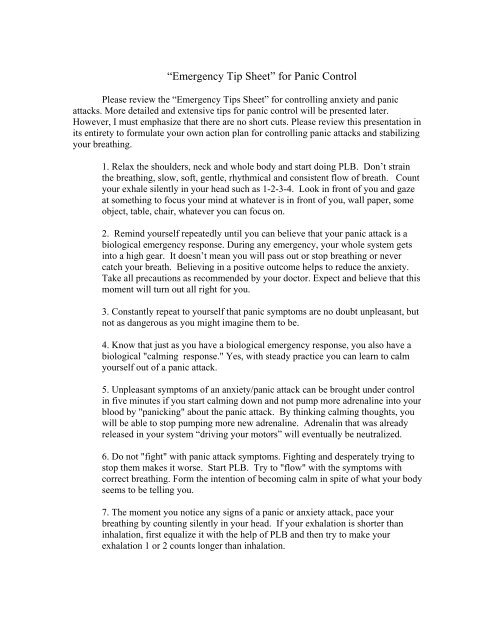Anxiety and Panic Attacks In Emphysema ... - Mind Publications
Anxiety and Panic Attacks In Emphysema ... - Mind Publications
Anxiety and Panic Attacks In Emphysema ... - Mind Publications
Create successful ePaper yourself
Turn your PDF publications into a flip-book with our unique Google optimized e-Paper software.
“Emergency Tip Sheet” for <strong>Panic</strong> Control<br />
Please review the “Emergency Tips Sheet” for controlling anxiety <strong>and</strong> panic<br />
attacks. More detailed <strong>and</strong> extensive tips for panic control will be presented later.<br />
However, I must emphasize that there are no short cuts. Please review this presentation in<br />
its entirety to formulate your own action plan for controlling panic attacks <strong>and</strong> stabilizing<br />
your breathing.<br />
1. Relax the shoulders, neck <strong>and</strong> whole body <strong>and</strong> start doing PLB. Don’t strain<br />
the breathing, slow, soft, gentle, rhythmical <strong>and</strong> consistent flow of breath. Count<br />
your exhale silently in your head such as 1-2-3-4. Look in front of you <strong>and</strong> gaze<br />
at something to focus your mind at whatever is in front of you, wall paper, some<br />
object, table, chair, whatever you can focus on.<br />
2. Remind yourself repeatedly until you can believe that your panic attack is a<br />
biological emergency response. During any emergency, your whole system gets<br />
into a high gear. It doesn’t mean you will pass out or stop breathing or never<br />
catch your breath. Believing in a positive outcome helps to reduce the anxiety.<br />
Take all precautions as recommended by your doctor. Expect <strong>and</strong> believe that this<br />
moment will turn out all right for you.<br />
3. Constantly repeat to yourself that panic symptoms are no doubt unpleasant, but<br />
not as dangerous as you might imagine them to be.<br />
4. Know that just as you have a biological emergency response, you also have a<br />
biological "calming response." Yes, with steady practice you can learn to calm<br />
yourself out of a panic attack.<br />
5. Unpleasant symptoms of an anxiety/panic attack can be brought under control<br />
in five minutes if you start calming down <strong>and</strong> not pump more adrenaline into your<br />
blood by "panicking" about the panic attack. By thinking calming thoughts, you<br />
will be able to stop pumping more new adrenaline. Adrenalin that was already<br />
released in your system “driving your motors” will eventually be neutralized.<br />
6. Do not "fight" with panic attack symptoms. Fighting <strong>and</strong> desperately trying to<br />
stop them makes it worse. Start PLB. Try to "flow" with the symptoms with<br />
correct breathing. Form the intention of becoming calm in spite of what your body<br />
seems to be telling you.<br />
7. The moment you notice any signs of a panic or anxiety attack, pace your<br />
breathing by counting silently in your head. If your exhalation is shorter than<br />
inhalation, first equalize it with the help of PLB <strong>and</strong> then try to make your<br />
exhalation 1 or 2 counts longer than inhalation.


